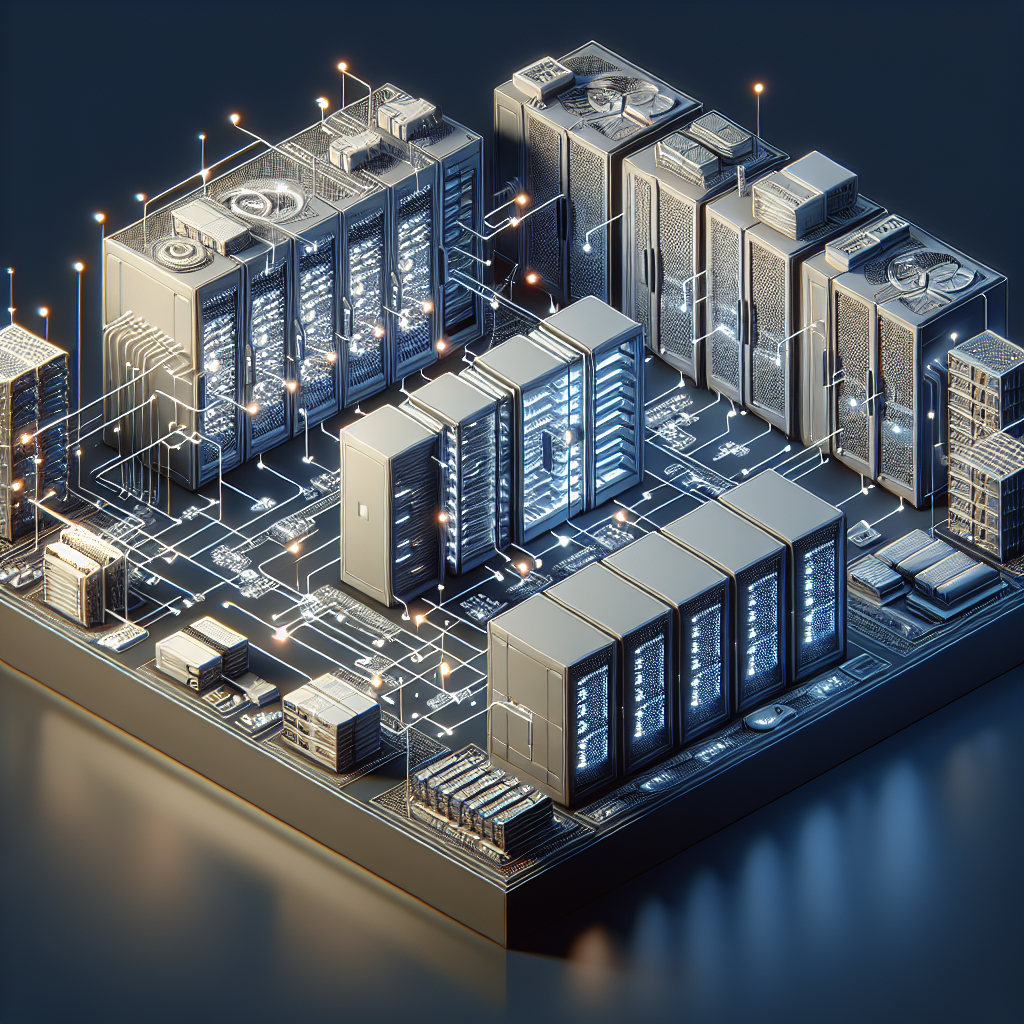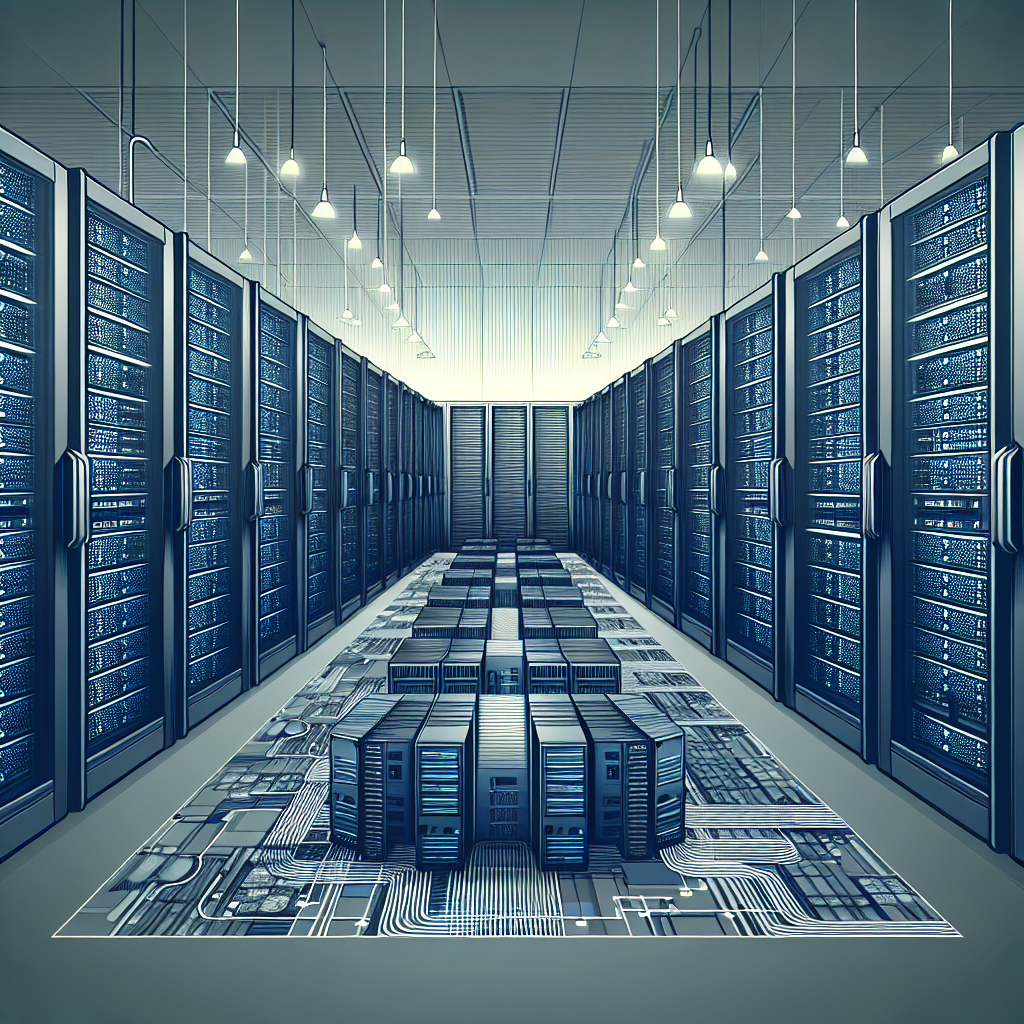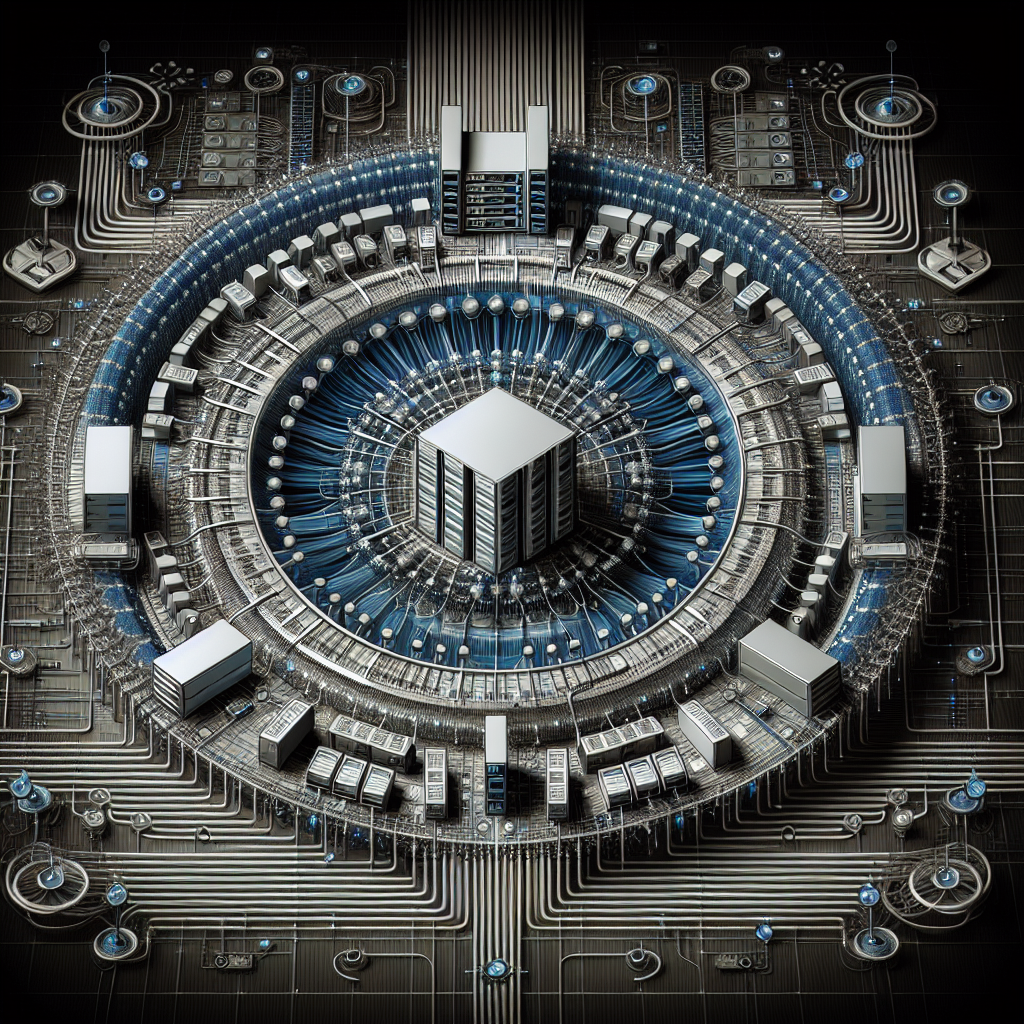Your cart is currently empty!
Tag: Scalability

Scalability and Flexibility: Key Components of Modern Data Center Network Infrastructure
In today’s fast-paced digital world, businesses are constantly looking for ways to stay ahead of the competition and meet the demands of their customers. One key component that is essential for achieving this is a scalable and flexible data center network infrastructure.Scalability refers to the ability of a network infrastructure to expand or contract in response to changing demands. This is crucial for businesses that experience fluctuating workloads or anticipate growth in the future. A scalable data center network can easily accommodate an increase in traffic, data storage, or processing power without experiencing downtime or performance issues.
Flexibility, on the other hand, refers to the ability of a network infrastructure to adapt to changing technologies, applications, or business requirements. A flexible data center network can easily integrate new software or hardware components, support different types of devices or protocols, and adjust to new trends or innovations in the industry.
To achieve scalability and flexibility in their data center network infrastructure, businesses must consider several key components:
1. Virtualization: Virtualization technology allows businesses to create virtual instances of servers, storage, and networking resources, enabling them to optimize their infrastructure and allocate resources more efficiently. This enables businesses to scale their network infrastructure easily and adapt to changing requirements without the need for physical hardware upgrades.
2. Software-defined networking (SDN): SDN separates the control plane from the data plane in a network, enabling businesses to centrally manage and configure their network infrastructure through software applications. This allows businesses to quickly adapt their network to changing demands, automate processes, and improve network performance.
3. Cloud computing: Cloud computing enables businesses to access computing resources and services over the internet, providing greater flexibility and scalability for data center network infrastructure. By leveraging cloud services, businesses can easily scale their network infrastructure, deploy new applications, and access resources on-demand without the need for significant upfront investments in physical hardware.
4. Automation: Automation tools enable businesses to streamline network management processes, reduce manual errors, and improve overall efficiency. By automating routine tasks such as configuration management, monitoring, and troubleshooting, businesses can free up resources to focus on strategic initiatives and ensure their network infrastructure is agile and responsive to changing demands.
In conclusion, scalability and flexibility are key components of modern data center network infrastructure that enable businesses to stay competitive, meet customer demands, and adapt to changing technologies and trends. By investing in virtualization, SDN, cloud computing, and automation, businesses can build a network infrastructure that is agile, efficient, and future-proof.

Maximizing Data Center Storage Capacity and Scalability
In today’s digital age, data centers play a crucial role in storing, managing, and processing vast amounts of information. With the exponential growth of data being generated and stored by businesses and organizations, maximizing data center storage capacity and scalability has become a top priority for IT professionals.One of the key challenges faced by data center managers is the constant need to expand storage capacity to accommodate the ever-increasing volume of data. Traditional storage solutions, such as hard disk drives (HDDs) and solid-state drives (SSDs), have limitations in terms of scalability and cost-effectiveness. To address this issue, many organizations are turning to software-defined storage (SDS) solutions that offer greater flexibility and scalability.
SDS enables organizations to pool and manage storage resources from multiple vendors and storage devices, such as HDDs, SSDs, and even cloud storage, through a centralized software platform. This allows for more efficient utilization of storage capacity and eliminates the need for costly hardware upgrades. Additionally, SDS solutions offer features such as data deduplication, compression, and tiering, which help maximize storage efficiency and reduce costs.
Another key aspect of maximizing data center storage capacity and scalability is implementing a scalable architecture that can easily accommodate future growth. Hyper-converged infrastructure (HCI) is a popular approach that combines compute, storage, and networking resources into a single, integrated system. HCI solutions offer seamless scalability, allowing organizations to add additional storage nodes or compute resources as needed without disrupting operations.
Furthermore, organizations can also leverage cloud storage services to augment their on-premises storage infrastructure. Cloud storage offers virtually unlimited scalability and flexibility, allowing organizations to quickly scale up or down based on their storage needs. By adopting a hybrid cloud storage strategy, organizations can take advantage of the benefits of both on-premises and cloud storage, ensuring optimal performance and cost-effectiveness.
In conclusion, maximizing data center storage capacity and scalability is crucial for organizations looking to effectively manage and store their ever-growing data volumes. By leveraging technologies such as SDS, HCI, and cloud storage, organizations can achieve greater storage efficiency, scalability, and cost-effectiveness. With the right storage solutions in place, organizations can meet the demands of today’s data-driven world and prepare for future growth and expansion.

Data Center Resilience: Why Redundancy and Scalability are Key
In today’s digital age, data centers are the backbone of businesses’ IT infrastructure. These facilities house and manage critical data and applications that are essential for everyday operations. As such, ensuring the resilience of data centers is of utmost importance to minimize downtime and ensure continuous service availability.One of the key factors in data center resilience is redundancy. Redundancy refers to the duplication of critical components within the data center infrastructure to ensure that there is no single point of failure. This means having backup power supplies, cooling systems, networking equipment, and storage devices in place to prevent any disruptions in service in the event of a hardware failure or power outage.
Redundancy is essential for maintaining high availability and uptime in data centers. By having redundant systems in place, data centers can continue to operate even if one component fails, ensuring that critical services remain online and accessible to users.
Scalability is another important aspect of data center resilience. Scalability refers to the ability of a data center to quickly and efficiently expand or contract its resources to meet changing demand. As businesses grow and evolve, their data center requirements also change, and having a scalable infrastructure in place is essential to accommodate these fluctuations.
Scalability allows data centers to easily add or remove servers, storage, and networking equipment as needed, without causing disruptions to ongoing operations. This flexibility ensures that data centers can adapt to changing business needs and continue to deliver high performance and reliability to users.
In conclusion, data center resilience is crucial for ensuring the continuous availability of critical services and applications. Redundancy and scalability are key components of a resilient data center infrastructure, helping to minimize downtime, prevent data loss, and maintain high levels of service availability. By investing in redundant and scalable infrastructure, businesses can ensure that their data centers are well-equipped to handle any potential disruptions and continue to deliver reliable services to their customers.

Scalability and Flexibility: Key Features of Modern Data Center Servers
In today’s fast-paced digital world, scalability and flexibility are key features that modern data center servers must possess in order to meet the increasing demands of businesses and organizations. Scalability refers to the ability of a system to handle a growing amount of work, or its potential to be enlarged to accommodate that growth. Flexibility, on the other hand, refers to the ability of a system to adapt and change easily in response to changing circumstances or requirements.Scalability and flexibility are crucial for data center servers because they allow organizations to easily expand their infrastructure as their needs grow, without having to completely overhaul their existing systems. This is particularly important in today’s data-driven world, where businesses are collecting and analyzing more data than ever before.
One of the key ways that modern data center servers achieve scalability is through virtualization. Virtualization allows multiple virtual servers to run on a single physical server, which enables organizations to easily scale up or down their computing resources as needed. This flexibility is essential for handling fluctuating workloads and ensuring that businesses can easily adapt to changing market conditions.
Another important feature of modern data center servers is the ability to easily add or remove storage capacity. With the increasing amount of data being generated and stored by organizations, having the ability to quickly expand storage capacity is essential. Modern data center servers often come equipped with hot-swappable drives, which allow for easy and quick installation of additional storage devices without having to power down the server.
In addition to scalability and flexibility, modern data center servers also prioritize energy efficiency. With the rising costs of electricity and the growing focus on sustainability, data centers are under pressure to reduce their energy consumption. Many modern servers are designed with energy-efficient components and power management features that help to minimize their environmental impact while still delivering high performance.
Overall, scalability and flexibility are key features that modern data center servers must possess in order to meet the growing demands of businesses and organizations. By investing in servers that prioritize these features, organizations can ensure that their infrastructure is able to grow and adapt to changing requirements, while also remaining energy-efficient and cost-effective.

The Importance of Data Center Capacity Planning: Ensuring Scalability and Efficiency
In today’s digital age, data centers play a crucial role in storing, processing, and managing the vast amounts of data generated by businesses and individuals. As the demand for data storage and processing continues to grow exponentially, it is more important than ever for organizations to effectively plan for and manage their data center capacity.Capacity planning is the process of determining the computing resources and infrastructure needed to meet current and future data processing requirements. It involves assessing the current capacity of a data center, predicting future growth, and implementing strategies to ensure scalability and efficiency.
One of the key benefits of data center capacity planning is ensuring scalability. By accurately predicting future data processing needs, organizations can avoid running out of storage or computing resources, which can lead to downtime, decreased productivity, and potential loss of revenue. Scalability also allows organizations to easily expand their data center infrastructure as their business grows, without having to overhaul their entire system.
Efficiency is another crucial aspect of data center capacity planning. By optimizing the utilization of resources, organizations can reduce energy consumption, lower operating costs, and minimize their environmental impact. Implementing energy-efficient technologies, such as virtualization and cloud computing, can help organizations maximize their data center capacity while minimizing their carbon footprint.
In addition to scalability and efficiency, data center capacity planning also helps organizations identify potential bottlenecks and performance issues before they occur. By monitoring key metrics such as CPU utilization, network traffic, and storage capacity, organizations can proactively address any issues that may hinder the performance of their data center.
Overall, effective data center capacity planning is essential for ensuring the long-term success and sustainability of an organization’s data infrastructure. By accurately predicting future growth, optimizing resource utilization, and proactively addressing performance issues, organizations can ensure that their data center is able to meet the demands of today’s digital economy.

Cable Management Strategies for Data Center Optimization and Scalability
Data centers are the backbone of modern technology, housing vast amounts of crucial data and applications. With the increasing demand for data storage and processing power, it is essential for data center operators to optimize and scale their infrastructure efficiently. One key aspect of data center optimization is cable management, as proper organization and maintenance of cables can significantly impact the performance and scalability of the data center.Effective cable management strategies can help reduce the risk of downtime, improve airflow and cooling efficiency, and allow for easier maintenance and upgrades. Here are some key cable management strategies for data center optimization and scalability:
1. Plan ahead: Before installing any equipment, take the time to plan out the layout of cables and equipment in the data center. Consider factors such as the location of power sources, networking equipment, and server racks to minimize cable runs and reduce the risk of cable congestion.
2. Use cable management tools: Invest in cable management tools such as cable trays, cable ties, and cable labels to keep cables organized and easily accessible. Properly labeling cables can help identify and troubleshoot issues quickly, reducing downtime and improving overall efficiency.
3. Implement color coding: Use color-coded cables to differentiate between different types of connections, such as power, networking, and storage. This can help streamline cable management and make it easier to trace cables when making changes or upgrades.
4. Utilize cable management solutions: Consider using cable management solutions such as cable management panels, cable management rings, and cable wraps to keep cables neat and organized. These solutions can help prevent cable tangling and reduce the risk of cable damage.
5. Regular maintenance: Regularly inspect cables for signs of wear or damage, and replace any damaged cables promptly. This can help prevent unexpected downtime and ensure the reliability of the data center infrastructure.
6. Scalability: When planning for scalability, consider future growth and expansion of the data center. Leave sufficient space for additional cables and equipment, and ensure that the cable management system can accommodate future upgrades without causing disruptions.
By implementing these cable management strategies, data center operators can optimize their infrastructure for improved performance, reliability, and scalability. Proper cable management not only enhances the overall efficiency of the data center but also reduces the risk of downtime and costly maintenance issues. Investing time and resources in effective cable management is essential for ensuring the long-term success and sustainability of a data center.

Scalability and Flexibility: How Data Center Servers Meet Growing Business Needs
In today’s fast-paced and ever-evolving business landscape, the need for scalability and flexibility in data center servers has never been more important. As businesses grow and expand, their data storage and processing requirements also increase, making it crucial for data center servers to be able to adapt to these changing needs.Scalability refers to the ability of a system, in this case, data center servers, to handle an increasing amount of work or its potential to accommodate growth. As businesses collect more and more data, they need servers that can scale up to meet their growing storage and processing demands. This means having servers that can easily add more storage capacity, processing power, and memory as needed, without causing any downtime or disruption to operations.
Flexibility, on the other hand, refers to the ability of data center servers to adapt to changing business requirements and technologies. With the rapid pace of technological advancements, businesses need servers that can support new applications, software, and services without the need for a complete overhaul of their infrastructure. This requires servers that are compatible with a wide range of operating systems, virtualization platforms, and cloud services, allowing businesses to easily integrate new technologies into their existing infrastructure.
Data center servers that offer scalability and flexibility help businesses meet their growing storage and processing needs while also future-proofing their infrastructure. By investing in servers that can easily scale up or down and adapt to new technologies, businesses can ensure that their data center infrastructure can support their growth and innovation for years to come.
One of the key ways data center servers achieve scalability and flexibility is through virtualization. By virtualizing their servers, businesses can create multiple virtual machines on a single physical server, allowing them to easily scale up or down their computing resources as needed. This not only improves efficiency and reduces costs but also provides businesses with the flexibility to quickly deploy new applications and services without the need for additional physical hardware.
In addition to virtualization, modern data center servers also offer features such as modular design, hot-swappable components, and software-defined storage and networking, all of which contribute to scalability and flexibility. These features allow businesses to easily expand their storage and processing capacity, replace faulty components without causing downtime, and adapt to changing business requirements and technologies.
In conclusion, scalability and flexibility are essential features of data center servers that help businesses meet their growing storage and processing needs while also adapting to new technologies and business requirements. By investing in servers that offer scalability and flexibility, businesses can future-proof their infrastructure and ensure that they can continue to innovate and grow in the ever-changing business landscape.

Scalability and Flexibility in Data Center IT Operations
In today’s rapidly evolving digital landscape, data centers play a crucial role in storing, processing, and managing vast amounts of data. As businesses continue to expand their online presence and adopt cloud computing technologies, the need for scalable and flexible IT operations within data centers has become more important than ever before.Scalability in data center IT operations refers to the ability to easily expand or shrink the capacity of resources, such as storage, compute power, and networking, in response to changing business needs. A scalable data center infrastructure allows organizations to accommodate sudden spikes in data traffic, handle increased workloads, and support the growth of their business without experiencing downtime or performance issues.
Flexibility, on the other hand, refers to the ability to adapt and reconfigure IT resources quickly and efficiently to meet changing requirements. A flexible data center environment enables organizations to deploy new applications, services, and technologies rapidly, respond to market demands, and optimize resource utilization without disruption to ongoing operations.
Achieving scalability and flexibility in data center IT operations requires a strategic approach that involves implementing the right technologies, processes, and best practices. Here are some key strategies for enhancing scalability and flexibility in data center operations:
1. Virtualization: Virtualization technology enables organizations to abstract physical hardware resources and create virtual instances that can be dynamically allocated and reallocated as needed. By virtualizing servers, storage, and networking components, data centers can achieve greater flexibility and scalability, as well as improve resource utilization and reduce costs.
2. Automation: Automation tools and processes can help streamline IT operations, accelerate deployment processes, and eliminate manual tasks. By automating routine tasks such as provisioning, configuration, and monitoring, data centers can improve efficiency, reduce errors, and free up IT staff to focus on more strategic initiatives.
3. Cloud computing: Leveraging cloud services and hybrid cloud environments can provide organizations with on-demand access to scalable resources, such as storage, compute power, and applications. By integrating cloud services into their data center infrastructure, organizations can enhance scalability, flexibility, and agility, while reducing capital expenses and operational overhead.
4. Software-defined networking (SDN): SDN technology enables organizations to programmatically control and manage their network infrastructure through software, allowing for greater agility, flexibility, and scalability. By decoupling network control from physical hardware, data centers can dynamically adjust network configurations, optimize traffic flow, and support new services and applications more efficiently.
5. Modular design: Adopting a modular data center design approach can help organizations build scalable and flexible IT infrastructure that can easily be expanded or upgraded as needed. By using standardized building blocks, such as pre-fabricated modules and containerized data centers, organizations can rapidly deploy new capacity, improve resource utilization, and reduce time-to-market.
In conclusion, scalability and flexibility are essential attributes for modern data center IT operations to support the dynamic needs of businesses in today’s digital economy. By implementing the right technologies, processes, and strategies, organizations can enhance their ability to scale resources, adapt to changing requirements, and optimize their IT operations for improved performance, efficiency, and agility.

Scalability and Flexibility: Designing a Future-Proof Data Center Network Infrastructure
In today’s fast-paced digital world, businesses are constantly facing the challenge of keeping up with the ever-increasing demand for data processing and storage. As data volumes continue to grow exponentially, the need for a scalable and flexible data center network infrastructure becomes more crucial than ever. Designing a future-proof data center network infrastructure that can adapt to changing business needs and technological advancements is essential for ensuring the long-term success of any organization.Scalability is a key factor in designing a future-proof data center network infrastructure. Scalability refers to the ability of a network to accommodate growth and expansion without requiring a complete overhaul of the existing infrastructure. A scalable network infrastructure should be able to easily add or remove resources as needed, without causing downtime or disruption to operations. This is particularly important in today’s dynamic business environment, where companies need to quickly respond to changing market conditions and customer demands.
Flexibility is another important aspect of designing a future-proof data center network infrastructure. A flexible network infrastructure is one that can easily adapt to new technologies and applications, without requiring significant reconfiguration or investment. This flexibility allows businesses to quickly implement new services and applications, without being limited by the constraints of their existing infrastructure. In addition, a flexible network infrastructure enables businesses to easily scale up or down their resources based on fluctuating demands, ensuring optimal performance and cost-efficiency.
To design a future-proof data center network infrastructure, businesses should consider a number of key factors. First and foremost, they need to assess their current and future data processing and storage requirements, and ensure that their network infrastructure is capable of meeting these needs. Businesses should also consider the scalability and flexibility of their network infrastructure, and choose technologies and solutions that can easily adapt to changing business requirements.
In addition, businesses should also consider the security and reliability of their network infrastructure. A future-proof data center network infrastructure should be able to protect sensitive data and applications from cyber threats and ensure high availability and uptime. This requires implementing robust security measures, such as firewalls, intrusion detection systems, and encryption technologies, as well as redundant power supplies and backup systems to ensure continuous operation in the event of a failure.
Ultimately, designing a future-proof data center network infrastructure requires a careful balance of scalability, flexibility, security, and reliability. By investing in the right technologies and solutions, businesses can ensure that their network infrastructure is able to support their current and future needs, and remain competitive in an increasingly digital world. With a well-designed and future-proof data center network infrastructure, businesses can confidently embrace new technologies and innovations, and drive their success in the digital age.

Future-proofing Data Center Electrical Systems for Growth and Scalability
In today’s fast-paced digital world, data centers are the backbone of organizations, supporting their critical operations and storing vast amounts of data. As businesses continue to grow and evolve, the demand for more powerful and efficient data center electrical systems is on the rise. To ensure that data centers can keep up with this increasing demand, it is crucial to future-proof their electrical systems for growth and scalability.One of the key considerations when future-proofing data center electrical systems is to design them with scalability in mind. This means building in the flexibility to easily add more capacity as needed, without having to overhaul the entire system. By incorporating modular components and scalable infrastructure, data centers can quickly adapt to changing requirements and accommodate future growth without causing disruptions to operations.
Another important aspect of future-proofing data center electrical systems is ensuring they are energy-efficient and sustainable. With the growing focus on environmental responsibility and the rising costs of energy, data centers need to prioritize efficiency in their electrical systems. This can be achieved through the use of energy-efficient equipment, smart power management systems, and renewable energy sources such as solar or wind power. By reducing energy consumption and minimizing their carbon footprint, data centers can lower operating costs and contribute to a more sustainable future.
In addition to scalability and energy efficiency, data center electrical systems must also be designed with reliability and redundancy in mind. Downtime can be costly for businesses, so it is essential to have backup power systems in place to ensure continuous operation in the event of a power outage. This can include uninterruptible power supply (UPS) systems, redundant power distribution units, and backup generators to provide a seamless transition during power disruptions.
Furthermore, as data centers continue to grow in size and complexity, it is important to consider the increasing power density requirements of modern IT equipment. High-density servers and storage systems can put a strain on traditional electrical systems, leading to overheating and performance issues. Future-proofing data center electrical systems involves implementing advanced cooling solutions, such as liquid cooling or hot aisle/cold aisle containment, to efficiently manage heat and maintain optimal operating conditions.
Overall, future-proofing data center electrical systems for growth and scalability is essential for organizations looking to stay ahead in today’s competitive business landscape. By designing systems with scalability, energy efficiency, reliability, and high power density in mind, data centers can ensure they are well-equipped to handle the demands of tomorrow’s digital world. Investing in advanced electrical infrastructure now will pay off in the long run, providing a solid foundation for continued growth and success in the future.
